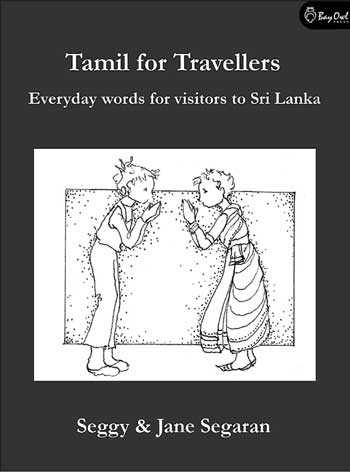Tuesday Mar 18, 2025
Tuesday Mar 18, 2025
Saturday, 19 January 2019 00:00 - - {{hitsCtrl.values.hits}}
 Whether your travel takes you overseas or to far-flung parts of the home country, there is no denying that you will have a better experience if you speak the local language. Although Sri Lanka speaks just three languages, many of us don’t stretch our linguistic capabilities to beyond two.
Whether your travel takes you overseas or to far-flung parts of the home country, there is no denying that you will have a better experience if you speak the local language. Although Sri Lanka speaks just three languages, many of us don’t stretch our linguistic capabilities to beyond two.
Our handicap is voluntary, and we are quick to cite privilege or the lack of it, time constraints in a busy schedule, or the flimsy excuse that once we left school, we became too old to learn. And yet, like all contemporary travellers, we want that immersive experience, we want to absorb local flavour or perhaps we just don’t want to be mistaken for foreigners in our own country.
There are many ‘teach-yourself’ books available on the market, and admittedly, none of them will enable proficiency overnight, but if all you are after is a quick fix that makes you stand out less in an unfamiliar place, then Seggy and Jane Segaran’s little book Tamil for Travellers – Everyday Words for Visitors to Sri Lanka, takes a step towards fulfilling that ambition and gives us a rudimentary vocabulary.
You may not speak Tamil fluently by the end of the book but you will be able to ask a few one or two-word questions like: When? Where? How much? More complicated questions like: What is he doing? or Where are we going? may give answers that the book or our basic skill doesn’t provide for.
Someone joked that with today’s flattening out of languages, all a tourist has to do in order to acquire a quick Sinhala vocabulary, is to simply append ‘eka’ to an English word – bus-eka, airport-eka, three-wheel-eka, ring-cut-ekak and they are good to go. Similarly, you will be happy to learn that with a slight alteration of accents or with the adaptation of harder consonants, Doktor, Dehntist, Ambulans, Hotal or Taksi seem to be understood in Tamil-speaking areas! An advantage for serious readers of this booklet is that after having given us a few words in categories such as directions, emergencies, time or travel, the Segarans give us sentences where words can be used interchangeably from within these sections, thereby increasing our grasp of usage.
Meal times are when travellers encounter the most number of problems. I remember a few years ago when, in a foreign country, I stared uncomprehendingly at a restaurant menu, the helpful waitress said: moo, baa-a and oink oink. Tamil for Travellers helps us out a little more and you will be able to say whether you are vegetarian or not, whether you are allergic to certain foods, and even what type of foods you like.
Many of the basic words are covered even if specific dishes and preparations are not, in the section At the Restaurant, which is followed with a sufficient selection of words in Food and Drink and of course, you will be able to call for the bill or chee-t-tu at the end of it. Fed and watered, you want to do the touristy thing and the book also provides enough words for a  shopping experience, whether you are looking for clothes or toiletries or curios – and if that type of souvenir is not what you are after, because you prefer nature and seeing animals, birds, marine life or even plants and trees you will gain enough of a vocabulary to keep you happy.
shopping experience, whether you are looking for clothes or toiletries or curios – and if that type of souvenir is not what you are after, because you prefer nature and seeing animals, birds, marine life or even plants and trees you will gain enough of a vocabulary to keep you happy.
One thing I have noticed in many countries that I have travelled to is that people are delighted to find you speak a few words of their language and will go out of their way to help you if you make the first overture.
As I said at the beginning, this book won’t make you a fluent Tamil speaker overnight – that will come with practice. However, it will help you break the ice and make new friends, thereby definitely enhancing your travel experience.
(Sam Perera is a partner of the Perera-Hussein Publishing House which publishes culturally relevant stories by emerging and established Lankan and regional authors – for a primarily Lankan audience. Ph books are available everywhere books are sold and through www.pererahussein.com.)
Discover Kapruka, the leading online shopping platform in Sri Lanka, where you can conveniently send Gifts and Flowers to your loved ones for any event including Valentine ’s Day. Explore a wide range of popular Shopping Categories on Kapruka, including Toys, Groceries, Electronics, Birthday Cakes, Fruits, Chocolates, Flower Bouquets, Clothing, Watches, Lingerie, Gift Sets and Jewellery. Also if you’re interested in selling with Kapruka, Partner Central by Kapruka is the best solution to start with. Moreover, through Kapruka Global Shop, you can also enjoy the convenience of purchasing products from renowned platforms like Amazon and eBay and have them delivered to Sri Lanka.
Discover Kapruka, the leading online shopping platform in Sri Lanka, where you can conveniently send Gifts and Flowers to your loved ones for any event including Valentine ’s Day. Explore a wide range of popular Shopping Categories on Kapruka, including Toys, Groceries, Electronics, Birthday Cakes, Fruits, Chocolates, Flower Bouquets, Clothing, Watches, Lingerie, Gift Sets and Jewellery. Also if you’re interested in selling with Kapruka, Partner Central by Kapruka is the best solution to start with. Moreover, through Kapruka Global Shop, you can also enjoy the convenience of purchasing products from renowned platforms like Amazon and eBay and have them delivered to Sri Lanka.